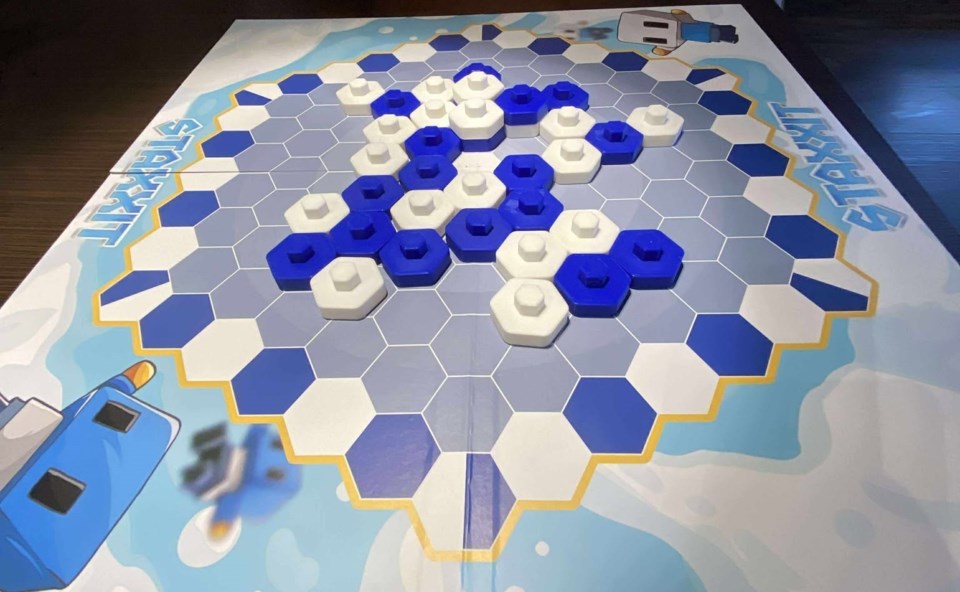YORKTON - There is a great deal of respect which goes out to game designers who don’t just come up with a design, but go the step of self-publishing.
Whether a game is great, or even flawed, the dedication to get it out in the world for gamers to explore is a huge undertaking if you are going it alone.
So hats off to designer Keimpe Wiersma who went the self-published route with his recent release Staxxit.
Now just to be clear off the start Staxxit is far from being a fail, although it’s not the next great abstract strategy game either.
What Staxxit is, is a very solid game based on the familiar stacking mechanic, which is sandwiched neatly between an initial placement phase, and the end game which has players trying to get their stacks off the ‘field’ to designated spots on an outer rim area.
Initially, the placement of your pieces seems a wholly random sort of effort although it is anticipated with repeat play, certain patterns for your pieces will emerge as more optimum than others.
Stacking is achieved by a sort of intermediary phase. After placements are done, captures moving on to opponent pieces, is mandatory if available.
Once all the possible captures available are done you can move, an effort which can lead to future forced captures.
The goal get your stacks off.
Once one person has all their stacks off the winner is the player who has the most stacks in the outer ring. So, yes you might gain an edge there, force an opponent capture of a last ‘on-board’ stack and win.
It’s a game option Meepler Trevor was not enamoured with, but it really does force you to get things close, and is ultimately just one of the quirks of the game.
Via email, designer Wiersma told The Meeple Guild, “the idea for this game came totally out of nowhere: at the start of my daily walk with the dogs, the thought “let’s create a board game” popped into my head and at the end of the walk a basic idea had formed. But when I started Googling, it turned out I had ‘invented’ something that looked very much like Abalone.
“So, literally the very next day I went back to square one (pun intended), tried again and ended up with the basic idea for Staxxit, which upon Googling (and checking Boardgamegeek.com) didn’t seem to exist yet.
“I made some wooden prototypes of the board, and used Lego for the pieces (because they can be stacked) and didn’t think too much of it, until I showed it to 11 and 12 year old kids at the school where my wife is a kindergarten teacher. It is only because of their enthusiasm that the game has evolved into what it is now. These kids also were instrumental in further refining the rules. They had a lot of very good questions and suggestions and the game literally evolved as we were playing it.”
The designer added, “I had also given myself some restrictions/challenges: it had to be an abstract game. I wanted it to become a “classic” like chess, checkers and go. So something that looks simple but has endless potential for complexity, and can be played by kids and grand masters alike. And everything had to be slightly, but uniquely different from chess, checkers and go. So the board, the squares, the number of squares, the number of pieces, the shape of the pieces, the way the game starts, the way it ends, the way you move, the way you capture: everything is “inspired” by the other games, but all with a unique twist.”
I will say the finished game is very nice. The pieces are chunky, move easily and stack like a charm, so the game is highly tactile and above average in terms of components.
Wiersma said the school experience suggests that might be a target audience for Staxxit.
“What players can expect is an abstract game like chess and checkers, but with everything just a little different, and for the time being, specifically targeted at a younger audience, because they were the most enthusiastic players,” he said.
“It would be a great addition for schools. The game involves logic, strategy and thinking a few steps ahead.”
That might be selling the game a bit short. Trevor and I are years removed from school, and generally we liked it – me probably more than he, but still this one came across as better than average. It won’t be top-five of the year, but it rates consideration for anyone wanting a nice looking, rather quick and not too ‘thinky’ a game that is a perfect information game.
Now Wiersma is hoping the game can find some home that allows it to grow.
“Unfortunately, my total lack of crowdfunding marketing experience resulted in the Kickstarter campaign ending up a TOTAL failure,” he said. “I wasn’t expecting that.
“And unless a “Deus ex machina” appears out of the blue, I’m afraid your English and my Dutch copy of Staxxit will be the only survivors of this long process -- which I enjoyed very much, mind you. I’m disappointed of course, but the whole process was a lot of fun.”
Follow the game’s future at staxxit.com






